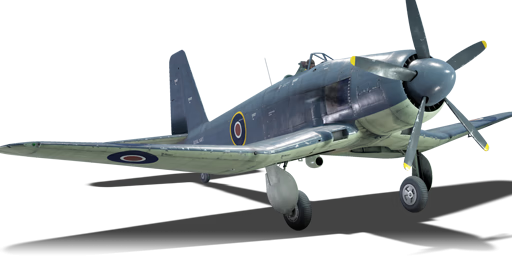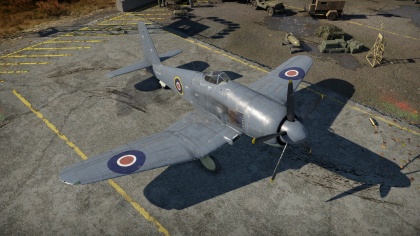Firecrest
Contents
Description
The Firecrest is a squadron rank II British fighter
with a battle rating of 2.7 (AB), 2.3 (RB), and 3.3 (SB). It was introduced during Update 1.89 "Imperial Navy".
General info
Flight performance
Describe how the aircraft behaves in the air. Speed, manoeuvrability, acceleration and allowable loads - these are the most important characteristics of the vehicle.
| Characteristics | |||||||
|---|---|---|---|---|---|---|---|
| Stock | |||||||
| Max Speed (km/h at 5,791 m) |
Max altitude (meters) |
Turn time (seconds) |
Rate of climb (meters/second) |
Take-off run (meters) | |||
| AB | RB | AB | RB | AB | RB | ||
| 587 | 568 | 10975 | 24.1 | 25.0 | 15.4 | 15.4 | 300 |
| Upgraded | |||||||
| Max Speed (km/h at 5,791 m) |
Max altitude (meters) |
Turn time (seconds) |
Rate of climb (meters/second) |
Take-off run (meters) | |||
| AB | RB | AB | RB | AB | RB | ||
| ??? | 608 | 10975 | ??.? | 23.0 | ??.? | 19 | 300 |
Details
| Features | ||||
|---|---|---|---|---|
| Combat flaps | Take-off flaps | Landing flaps | Air brakes | Arrestor gear |
| ✓ | ✓ | ✓ | ✓ | ✓ |
| Limits | ||||
|---|---|---|---|---|
| Wing-break speed (km/h) |
Gear limit (km/h) |
Combat flaps (km/h) |
Max Static G | |
| + | - | |||
| 430 | ~10 | ~4 | ||
| Optimal velocities | |||
|---|---|---|---|
| Ailerons (km/h) |
Rudder (km/h) |
Elevators (km/h) |
Radiator (km/h) |
| < 460 | < 450 | < 450 | > 330 |
| Compressor (RB/SB) | ||
|---|---|---|
| Setting 1 | ||
| Optimal altitude | 100% Engine power | WEP Engine power |
| 1,280 m | 2,580 hp | 2,895 hp |
| Setting 2 | ||
| Optimal altitude | 100% Engine power | WEP Engine power |
| 4,980 m | 2,310 hp | 2,587 hp |
Survivability and armour
Examine the survivability of the aircraft. Note how vulnerable the structure is and how secure the pilot is, whether the fuel tanks are armoured, etc. Describe the armour, if there is any, and also mention the vulnerability of other critical aircraft systems.
Armaments
Offensive armament
The Firecrest is armed with:
- 2 x 12.7 mm Browning M3 machine guns, wing-mounted (300 rpg = 600 total)
Suspended armament
The Firecrest can be outfitted with the following ordnance:
- Without load
- 2 x 500 lb G.P. 500 lb Mk.IV bombs (1,000 lb total)
- 1 x Mark XV torpedo
- 8 x RP-3 rockets
Usage in battles
The Firecrest is a sub-average torpedo bomber with decent survive-ability. It has minimal effectiveness in air battles and almost no place in tank battles, however it has a place in naval battles (once the Mark XV torpedo is unlocked for use).
Due to the lackluster firepower with only two machine guns, one of the recommended ways to gain the necessary research points for unlocking modules is to simply attack AI targets like artillery and trucks, then tanks as the 500 lb bombs are unlocked prior to the torpedoes.
Once the torpedoes are unlocked, the Firecrest performs similarly to other torpedo bombers of the rank. Its only outstanding trait is in its high survive-ability that can help in destroying one target if the tactics are played to the plane's strength. Aim towards destroyer or cruiser as they are larger targets that are easier to hit and prioritize the vessels that are threatening allies on the seas. However, try to ensure the enemy ship is occupied with attacking surface targets so that their anti-air armament is not focused on the Firecrest to allow for some breathing room to position for an attack run.
Manual Engine Control
| MEC elements | ||||||
|---|---|---|---|---|---|---|
| Mixer | Pitch | Radiator | Supercharger | Turbocharger | ||
| Oil | Water | Type | ||||
| Not controllable | Not controllable Auto control available |
Controllable Auto control available |
Controllable Auto control available |
Separate | Controllable 2 gears |
Not controllable |
Modules
| Tier | Flight performance | Survivability | Weaponry | ||
|---|---|---|---|---|---|
| I | Fuselage repair | Radiator | HMBC mk.2 | ||
| II | Compressor | Airframe | Offensive 12 mm | FTC mk.IV | |
| III | Wings repair | Engine | HRC mk.8 | ||
| IV | Engine injection | Cover | New 12 mm MGs | ||
Pros and cons
Pros:
- M3 .50 cals can do serious damage if used correctly, and have a high rate of fire
- Good top speed overall
- Respectably durable
- RP-3 can be very usefull against tanks in Ground RB
Cons:
- Not very maneuverable, especially at low speeds
- Only two machine guns means limited damage output at the rank
- Limited payload options
History
The Blackburn Firecrest was a British Torpedo Strike Fighter, derived from the earlier Blackburn Firebrand but designed from the outset as a torpedo strike fighter. Designed to the S.28/43 specification set by the Admiralty on February 26th 1943 for a 'Firebrand Torpedo Fighter with improved wing and improved pilot view', the Firecrest was designed with a number of issues of the Firebrand in mind. Specifically, effort was done to produce a type which had improved forward visibility to facilitate deck landings, and which had better lateral control at landing speeds. The design specification also called for the Firecrest to be powered by a Bristol Centaurus 77 engine powering a contra-rotating propeller.
Early on during its design, the Admiralty also ordered three prototypes which would have been driven by the Napier E.122 24-cylinder H-block engine, a 3500 hp development of the Napier Sabre used on the original Firebrand. However, it was soon found that in order to maintain an acceptable center of gravity, the heavy Napier engine would have to be installed behind the cockpit, which would require an extensive redesign and add considerable weight to the aircraft. As a result, the Napier E.122 powered variant was cancelled in October of 1945 before metal was cut on any of their prototypes. Just before completion of the design, the Centaurus 77 variant with its contra-rotating propeller was cancelled in January of 1946, and it was replaced by a 2,825 hp Centaurus 57 with a conventional five-bladed propeller. The first of three completed prototypes of the Firecrest flew on April 1st 1947.
The Firecrest differed from the Firebrand in having a cockpit that was set higher and more forward than that of the Firebrand, which combined with a shortened nose did improve the forward visibility during deck landing. A redesigned inverted gull wing conceptually not unlike that of the Vought Corsair did much to improve the type's low speed handling and take off characteristics: even at full weight, take-off was possible in just under 430 ft with a 29 mph headwind; it's landing run was an impressive 390 ft with a 5 mph headwind. With its conventional five-bladed propeller, the Firecrest's top speed lay at 380 mph, some 38 mph faster than the Firebrand despite weighing slightly more. Unlike the Firebrand which used hand-folded wings, the Firecrest had power-assisted folding wings with a double fold.
However, it soon became apparent that the Firecrest was even more sluggish in handling than the Firebrand, that the design in itself did not give any distinct advantages over the Firebrand or the newly developed Westland Wyvern, and that it was less versatile than types such as the Fairey Firefly or Hawker Sea Fury. As a result, all development work on the Firecrest ceased in September of 1947, with the second prototype only being used for structural testing, and the third prototype used to test the power-boosted ailerons which were eventually fitted to the Firebrand TF.5A. All three prototypes were bought back by Blackburn in 1950, and scrapped in 1952.
Media
Excellent additions to the article would be video guides, screenshots from the game, and photos.
See also
Links to the articles on the War Thunder Wiki that you think will be useful for the reader, for example:
- reference to the series of the aircraft;
- links to approximate analogues of other nations and research trees.
External links
Paste links to sources and external resources, such as:
- topic on the official game forum;
- encyclopedia page on the aircraft;
- other literature.
| Blackburn Aircraft Ltd. | |
|---|---|
| Fighters | Firebrand TF Mk IV · Firecrest |
| Strike aircraft | Buccaneer S.1 · Buccaneer S.2 · Buccaneer S.2B |
| Britain squadron aircraft | |
|---|---|





